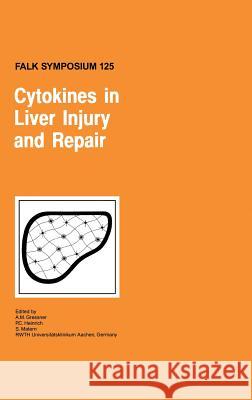Cytokines in Liver Injury and Repair » książka
Cytokines in Liver Injury and Repair
ISBN-13: 9780792387756 / Angielski / Twarda / 2002 / 400 str.
This book, the proceedings of Falk Symposium No. 125 on 'Cytokines in Liver Injury and Repair' (Progress in Gastroenterology and Hepatology Part II), held in Hannover, Germany, on September 30 - October 1, 2001, provides an update of our current knowledge on the role of cytokines in various human and experimental liver diseases and on their present and prospective use in therapeutic trials. Developments in recent years include: Since the first report of a cytokine knockout mouse for IL-2 in 1991 a large number of cytokine and cytokine receptor genes have been inactivated in mouse germlines and the corresponding mutant mice have provided a wealth of novel information. In addition, targeted-gene disruption techniques (e.g. cre-loxP) and liver-specific overexpression of certain cytokines have provided clues for the understanding of their role in the pathophysiology of liver diseases. The number of well-characterized cytokines, chemokines, and growth factors is ever growing and it becomes increasingly evident that they are effective in a complex network of positive and negative signals. A disruption of this homeostatic balance is a direct cause of disease, determines its complications, and is related to its progression, e.g. in inflammation and fibrogenesis. Signaling pathways from receptors to target genes have been dissected and now we are beginning to recognize highly complicated cross-talks between various signal transduction pathways and interferences with non-cytokine mediators such as reactive oxygen metabolites (ROS), lipid mediators, physical factors, and others leading to an almost incomprehensible vastness of agonistic and antagonistic signals. Today, we understand in greater detail the extracellular control mechanisms of cytokine and growth factor bioavailability and its importance for pathophysiological mechanisms. During these processes the secretion of (latent) proforms of cytokines, their extracellular or transmembraneous immobilization and sustained proteolytic activation and their release into the immediate environment of cells play major roles and the possibility of autocrine, paracrine, juxtacrine, and endocrine signal transfer. Finally, experimental and beginning clinical uses of proteins or gene transfer technologies for cytokine antagonism, scavenging, receptor blockade, and inhibition of signal cascades in therapeutic trials offer hopeful perspectives in the treatment of malign and benign liver diseases. Gene-therapeutic application of molecular-engineered 'designer cytokines', e.g. of hyper-IL-6, promises clinical benefit for the treatment of fulminant hepatic failure. The book contains chapters by most well-known experts in the field who have contributed significantly to our present knowledge on cytokines in liver injury and repair.











